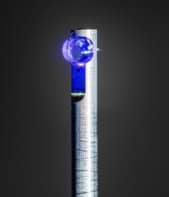The resolution possible in most imaging techniques is limited by the wavelength of radiation that is used to image the object. This so-called diffraction limit can be overcome by illuminating the sample through a sub-wavelength aperture. The image is obtained by placing the aperture very close to the sample and collecting the light that is transmitted as the aperture is moved over it.
However, the resolution possible with scanning near-field optical microscopy (NSOM), as this approach is called, is essentially limited by the size of the aperture. To improve the resolution it is necessary to use ever smaller apertures, or to replace the aperture with an extremely small light source. A team of physicists at the University of Konstanz in Germany has now taken this latter approach to the extreme and used the light from a single molecule instead of an aperture (J Michaelis et al. 2000 Nature 405 325). The technique was used to obtain images of a hexagonal lattice of 25 nanometre high triangles on an aluminium surface.
Vahid Sandoghdar and colleagues started by growing micron-sized crystals of p-terphenyl that contained about one molecule of terrylyne for every ten million molecules of the host. A suitable microcrystal was then glued to the end of an optical fibre. The low doping concentration of the crystal and operation at 1.4 kelvin meant that a single terrylene molecule could be selectively excited by laser radiation. The photons emitted from the molecule then passed through the sample and various optics before being detected by an avalanche photodiode.
By moving the sample relative to the fibre, it was possible to build up an image. Moreover, the quality of the image improved as the sample-probe separation was reduced from 350 nm to 20 nm. Although the images are not yet as good as those obtained with the best optical near-field microscopes, the Konstanz team hope to improve the resolution of their technique by using smaller microcrystals and different ways to excite the molecules near the end of the crystals.



